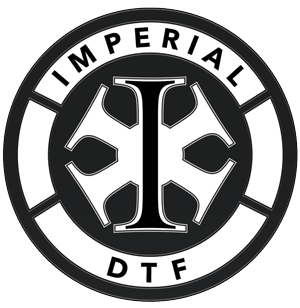The type of DTF (Direct-to-Film) adhesive absolutely affects how the finished transfer feels on a shirt (the “hand feel”). You've seen the sales pitch that their ink has the best hand-feel - but DTF ink has very little to do with the hand-feel, it is the adhesive, sizes of particles, the chemistry of it, and how much powder is being picked up by the DTF white ink. To truly get the best feeling prints and premium quality prints you should know the supplies you are using.
First, let's go over the different adhesives and composition:
Adhesive Type and Texture
There are two main types of DTF adhesive powders in terms of how they're milled and the chemical composition:

Particle Size:
-
Fine powder (smooth / soft hand feel)
-
Creates a thinner adhesive layer.
-
Feels softer and more flexible on fabric.
-
Great for lighter fabrics or when you want a premium, “barely there” feel.
-
However, it may have slightly less durability on heavy wear items.
-
-
Medium or coarse powder (thicker / stiffer feel)
-
Produces a stronger bond and more durability.
-
The transfer may feel more rubbery or slightly raised.
-
Common for workwear or items that need to withstand heavy washing.
-

Composition Differences:
Polyurethane (TPU) DTF Powder
-
Composition: Polyurethane DTF powder is a thermoplastic polyurethane hot melt adhesive in fine powder form. It acts as a bonding agent between the printed DTF transfer film and the fabric.
-
Texture/Appearance: Fine white powder, smooth and consistent.
-
Melting Point: Generally 90–110°C (194–230°F).
-
Hand Feel: Produces a softer, more flexible hand feel after transfer.
-
Bond Strength: Excellent adhesion to fabrics, especially cotton and blends.
-
Durability: Good wash resistance and stretchability.
-
Best For: When you want a soft, natural feel and smooth finish on garments.
Pros:
- Softer feel
- Flexible and stretchable
- Reliable adhesion
- Great for fashion/apparel printing
Cons:
- Slightly lower melting temp — can be sensitive to excessive heat or pressure
- Not quite as aggressive of adhesion as the ethylene-based DTF adhesive on difficult fabrics like windbreakers etc.
Ethylene (Often Refers to Ethylene-Based Copolymers, like EVA) DTF Powder
-
Composition: Made from ethylene–vinyl acetate (EVA) or other ethylene copolymers.
-
Texture/Appearance: Similar fine powder, but slightly waxier.
-
Melting Point: Slightly higher (100–130°C / 212–266°F).
-
Hand Feel: Firmer or slightly rubbery finish compared to polyethylene.
-
Bond Strength: Very strong adhesion; great for synthetics and harder surfaces.
-
Durability: Excellent resistance to washing and abrasion.
-
Best For: When you want high durability and don’t mind a firmer feel.
Pros:
- Strong adhesion
- Excellent durability
- Works well on polyester or treated fabrics
Cons:
- Stiffer hand feel
- Can add a thicker layer to the print

Printing Variables
Even with the same adhesive, how you prepare or print the image has a huge affect on the feel of the print. Here are some printing variables that can affect the quality of the feel of the print:
- White underbase with no halftone effects or too thick of white underbase. The white ink is what picks up the adhesive, more white ink typically the more adhesive that is picked up.
- Too wet of ink going into the powdering process. The high printer bed temperature or additional heat on the guide table will minimize how much adhesive is picked up. The challenge is too much heat will inhibit the print from picking up enough adhesive leading to poor adhesion on fine print areas.
Application Variables
Even with the same adhesive, the press settings also impact the feel:
-
Too much heat → adhesive over-melts, feels thick or rubbery.
-
Too little heat/time → adhesive under-melts, feels grainy or stiff.
-
Pressure also affects smoothness; higher pressure usually gives a more slick or glossy look. Too much pressure & heat can make the transfer brittle.
Adhesive Quality
Higher-quality adhesives melt and flow better during pressing, resulting in:
-
Smoother texture
-
Better wash resistance
-
Less “crunchy” or plastic feel
Cheaper adhesives often leave a gritty or rough surface because they don’t fully melt or integrate with the ink layer.
The DTF adhesive powder type and quality significantly affect how soft, flexible, or rubbery the transfer feels. If you want a softer result, go for fine-grain, high-quality adhesive powder polyethylene based, like Galactic White Booster or Starbase DTF adhesive powder.
______________________________
Article written by DTF Tech Gurus, our official installer and service technicians of the X5 DTF Production Printer.
DTF Tech Gurus is an employee-owned company dedicated to delivering expert technical support for Direct-to-Film printing systems—without the high costs and slow service often associated with corporate distributors.
DTF Tech Gurus eliminates the frustration of slow or unhelpful support. Their Remote Service Support ticketing system ensures fast, efficient troubleshooting—handled by experts who genuinely understand the technology and urgency of keeping your production running.


